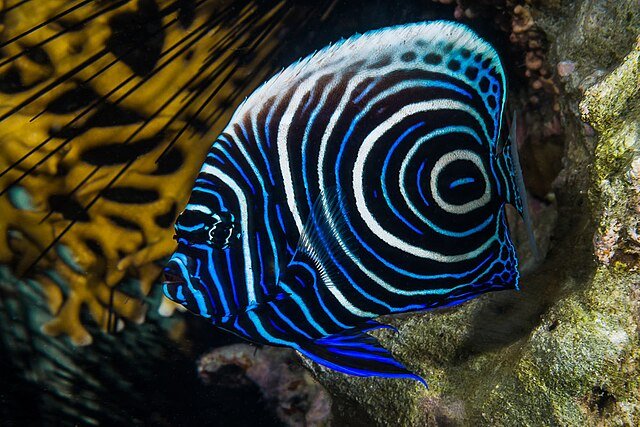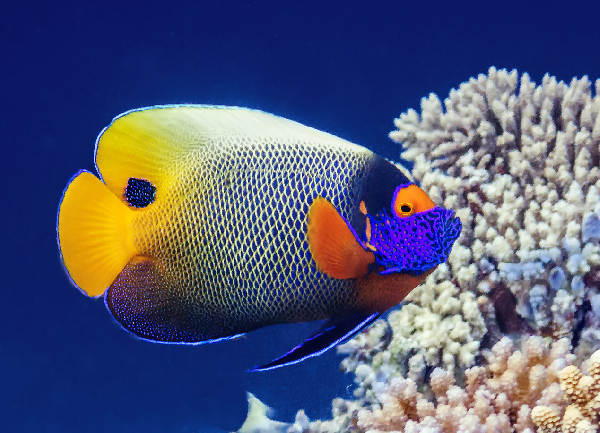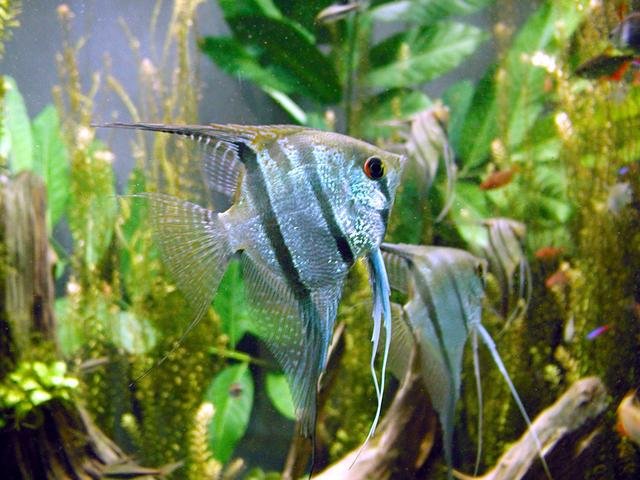
The emperor angelfish, Pomacanthus imperator, is one of the most majestic and visually stunning marine fish. Native to the Indo-Pacific region, this species is revered by marine enthusiasts for its spectacular color transformation from juvenile to adult stages.
This article delves into all the essential aspects of caring for emperor angelfish, including habitat, diet, tank setup, reproduction, compatibility with other species, and considerations to keep in mind when housing them with corals.
Characteristics of the Emperor Angelfish
Taxonomy
Kingdom: Animalia
Phylum: Chordata
Class: Actinopterygii
Order: Perciformes
Family: Pomacanthidae
Genus: Pomacanthus
Species: Pomacanthus imperator (Bloch, 1787)
Common name in Spanish: pez ángel emperador
Common names in English: imperial angelfish, emperor angelfish
Ye et al. (2015) sequenced the mitogenome of the emperor angelfish, Pomacanthus imperator; the assembled mitogenome consists of 16,538 bp, including 13 protein-coding genes, 22 transfer RNAs, and two ribosomal RNA genes.
Physical Characteristics of the Emperor Angelfish
The emperor angelfish is known for its distinctive and vibrant appearance that evolves as it matures. It can live between 10 to 15 years, weigh up to 1.4 kilograms, and reach a length of 38 to 40 cm. Sulkifli et al. (2023) estimated that the growth rate of Pomacanthus imperator is 0.4934 cm/year, with a maximum length of 41.7 cm at 10 years of age.
Juvenile emperor angelfish (Pomacanthus imperator) are characterized by striking concentric circles of dark blue and white, while adults display bold horizontal stripes of yellow and blue with a black “mask” around the eyes. The color change is one of nature’s most fascinating transformations and typically occurs over a period of 24 to 30 months (when the fish reaches 8 to 12 cm in total length), depending on environmental conditions.

Adult emperor angelfish (P. imperator) have alternating fine yellow and blue stripes along their flanks, a yellowish-green nape, a dark “mask” over the eyes, and a light blue snout. The dorsal fin has a white edge; the caudal fin is yellow; and the anal fin has light blue stripes on a dark blue background.
Habitat of the Emperor Angelfish (P. imperator)
In the wild, emperor angelfish inhabit the warm tropical waters of coral reefs in regions such as the Red Sea, East Africa, and Australia. They are either solitary or form small harems and fiercely defend their territories.
Stay Always Informed
Join our communities to instantly receive the most important news, reports, and analysis from the aquaculture industry.
Emperor angelfish (P. imperator) can be found at depths ranging from 1 to 100 meters. According to research by Woo and Chung (1995), it is a “physiologically euryhaline” species.
The ideal aquarium setup should mimic their natural reef environment, providing plenty of live rock for grazing and caves for hiding.
Reproduction of the Emperor Angelfish
Breeding emperor angelfish (Pomacanthus imperator) in captivity is complicated due to the specific requirements of their natural environment and reproductive behavior. Here are the key aspects:
Reproductive Behavior
In the wild, emperor angelfish (P. imperator) reach sexual maturity at around 25 cm (TL) for females and 28 cm (TL) for males (Obota et al., 2016). These fish are protogynous hermaphrodites (born female and later transition to male).
They typically form harems consisting of a dominant male and several females (2 to 5). The hierarchical system is designed to maximize reproductive opportunities. The male aggressively defends his territory, ensuring that the females do not stray far and keeping other males away.
Courtship, Spawning, and Fertilization
Emperor angel fish have been observed performing elaborate courtship rituals, including sinuous movements and vibrant color displays to attract females. Thresher (1982) describes the courtship and spawning of P. imperator, noting that these events occur at dusk, continue throughout most of the lunar month, and are preceded by the male’s display to the female. Spawning culminates in the release of gametes into the water column, forming a floating cloud that disperses with the current.
The eggs of the emperor angelfish are pelagic, meaning they float freely and are carried by ocean currents. Obota et al. (2016) reported fecundity estimates ranging from 17,790 to 266,472, with an average of 79,353 ± 11,747, linearly correlated with total length and ovary weight. Egg size varies between 0.3 and 0.8 mm in a single spawning event.
Challenges in Captivity
Successfully breeding emperor angel fish in an aquarium presents several significant challenges. First, an extremely large tank is required, ideally capable of simulating the lighting and current conditions of their natural habitat. Additionally, establishing a stable breeding harem or pair can be difficult due to aggression and territorial dynamics. Sexual maturation also takes time, generally several years, and requires specific water conditions, such as stable temperature and appropriate pH and salinity levels.
Larval Care
Once the eggs hatch, the larvae face numerous challenges. They are highly sensitive to water fluctuations and require a constant supply of high-quality live food, such as rotifers and Artemia nauplii. The larvae also need a nutrient-rich and well-oxygenated environment for proper development. In captivity, precisely recreating these conditions is a major challenge, and many larvae do not survive beyond the first few weeks.
Diet and Feeding of Emperor Angelfish
Emperor angelfish are omnivorous, with their diet becoming more herbivorous as they age. In the wild, they feed on sponges, algae, and small invertebrates. Reproducing this diet in captivity is challenging, but a mix of seaweed, vitamin-enriched flakes, brine shrimp, mysis shrimp, and chopped seafood (such as squid and mussels) is recommended. Feeding should be done 2 to 3 times a day to ensure adequate nutrition and minimize aggression during feeding times.
Care of the Emperor Angelfish
Emperor angelfish (P. imperator) require diligent care to thrive in a home aquarium. Water quality is paramount; Table 01 outlines the basic water requirements for keeping this species.
Table 01. Water Quality Parameters for Keeping Emperor Angelfish (Pomacanthus imperator).
| Parameters | Range |
| Tank Size | Juveniles: 500 liters (125 gallons) Adults: 800 liters (200 gallons) |
| Water Temperature | 72 to 82 °F (22 – 28 °C) |
| Water pH | 8.1 to 8.4 |
| Salinity | 1.022 to 1.024 |
| Water Hardness | 10 Kh |
| Nitrates | <50 mg/L |
| Monthly Water Change | 20% – 30% |
Compatibility and Tank Mates
Choosing suitable tank mates is crucial due to the semi-aggressive nature of the emperor angelfish. Suitable companions include large, non-aggressive fish such as surgeonfish, clownfish, wrasses, and certain butterflyfish. Avoid housing them with smaller, delicate species or other angelfish to prevent territorial disputes.
Are Emperor Angelfish Reef-Safe?
The short answer is: it depends. Juveniles are more reef-compatible, but adults often develop a taste for coral polyps and invertebrates. If you keep one in a reef tank, provide plenty of alternative food sources and monitor their behavior closely. Some aquarists have had success with hardy coral species and strategic feeding, but there is always a risk of coral damage.
Diseases
Common health issues include ich, marine velvet, and head and lateral line erosion, often related to stress or poor water quality. Quarantining new arrivals and using a UV sterilizer can prevent many diseases.
De Lucca et al. (2020) reported the presence of Lymphocystivirus in P. imperator in Brazil, while Palsamy et al. (2020) first identified the digenetic parasite Paradiscogaster mannari n. sp. in the emperor angelfish in a marine aquarium in India.
Conclusion
The emperor angelfish is a captivating but demanding marine species, best suited for experienced aquarists willing to invest in large tanks and meticulous care routines. Understanding their needs, from diet to habitat, is essential to ensure a healthy, vibrant fish that can live close to its natural lifespan. With careful planning and dedication, you can enjoy the beauty of one of the ocean’s most elegant inhabitants.
On the other hand, if you are going to acquire an emperor angelfish, make sure that it comes from sources that carry out responsible fishing catches and that guarantee the conservation of the species.
Reference
de Lucca Maganha, S.R., Cardoso, P.H.M., de Carvalho Balian, S. et al. Detection and molecular characterization of Lymphocystivirus in Brazilian ornamental fish. Braz J Microbiol 51, 531–535 (2020). https://doi.org/10.1007/s42770-019-00196-x
Obota, C. O., Fulanda, B. M., Okemwa, G. M., & Kimani, E. N. (2016). Reproductive biology and body condition of exploited populations of Emperor Angelfish, Pomacanthus imperator (Bloch, 1787) along the Kenyan Coast. Western Indian Ocean Journal of Marine Science, 15(2), 19-30.
Palsamy, R.K., Raju, S., Sanil, N.K. et al. A new digenetic trematode Paradiscogaster mannari n. sp. (Faustulidae) from the emperor angel fish Pomacanthus imperator from Gulf of Mannar, India. J Parasit Dis 44, 137–144 (2020). https://doi.org/10.1007/s12639-019-01175-7
Sulkifli, S., Mauli Kasmi, & Yusri Muhammad Yusuf. (2023). Size Structure, Long-Weight Relations And Growth Angel Ornamental Fish (Pomacanthus Imperator) In Spermonde Waters, South Sulawesi, Indonesia. International Journal of Technology and Education Research, 1(02), 51-64.
Thresher, R.E. Courtship and spawning in the emperor angelfish Pomacanthus imperator, with comments on reproduction by other pomacanthid fishes. Mar. Biol. 70, 149–156 (1982). https://doi.org/10.1007/BF00397679
Woo N. Y., & Chung, K. C. (1995). Tolerance of Pomacanthus imperator to hypoosmotic salinities: Changes in body composition and hepatic enzyme activities. Journal of Fish Biology, 47(1), 70-81. https://doi.org/10.1111/j.1095-8649.1995.tb01874.x
Ye, J. J., Shen, K. N., Chen, C. H., Hsiao, C. D., & Chang, C. W. (2015). The complete mitochondrial genome of the Emperor angelfish, Pomacanthus imperator (Perciformes: Pomacanthidae). Mitochondrial DNA Part A, 27(6), 4126–4127. https://doi.org/10.3109/19401736.2014.1003875
Editor at the digital magazine AquaHoy. He holds a degree in Aquaculture Biology from the National University of Santa (UNS) and a Master’s degree in Science and Innovation Management from the Polytechnic University of Valencia, with postgraduate diplomas in Business Innovation and Innovation Management. He possesses extensive experience in the aquaculture and fisheries sector, having led the Fisheries Innovation Unit of the National Program for Innovation in Fisheries and Aquaculture (PNIPA). He has served as a senior consultant in technology watch, an innovation project formulator and advisor, and a lecturer at UNS. He is a member of the Peruvian College of Biologists and was recognized by the World Aquaculture Society (WAS) in 2016 for his contribution to aquaculture.




